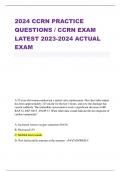Exam (elaborations)
2024 CCRN PRACTICE QUESTIONS / CCRN EXAM LATEST ACTUAL EXAM
- Course
- Institution
2024 CCRN PRACTICE QUESTIONS / CCRN EXAM LATEST ACTUAL EXAM A 35-year-old woman underwent a mitral valve replacement. Her chest tube output has been approximately 125 mL/hr for the last 3 hours, and now the drainage has ceased suddenly. The immediate assessment reveals a significant decrease in B...
[Show more]



